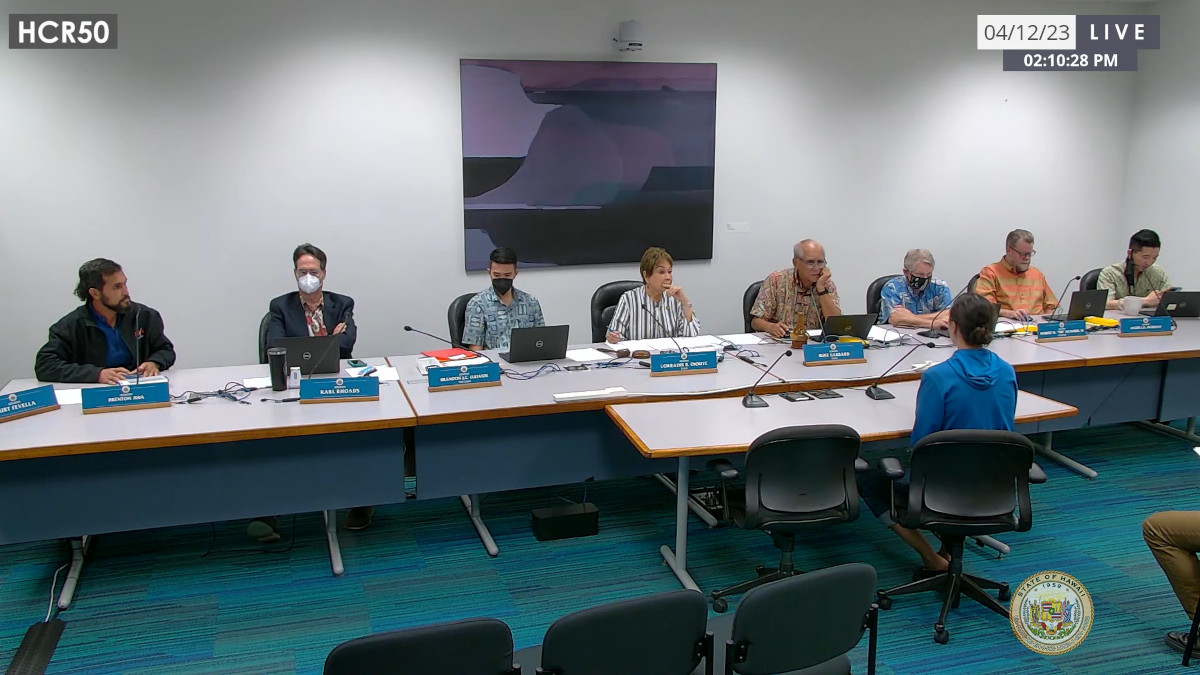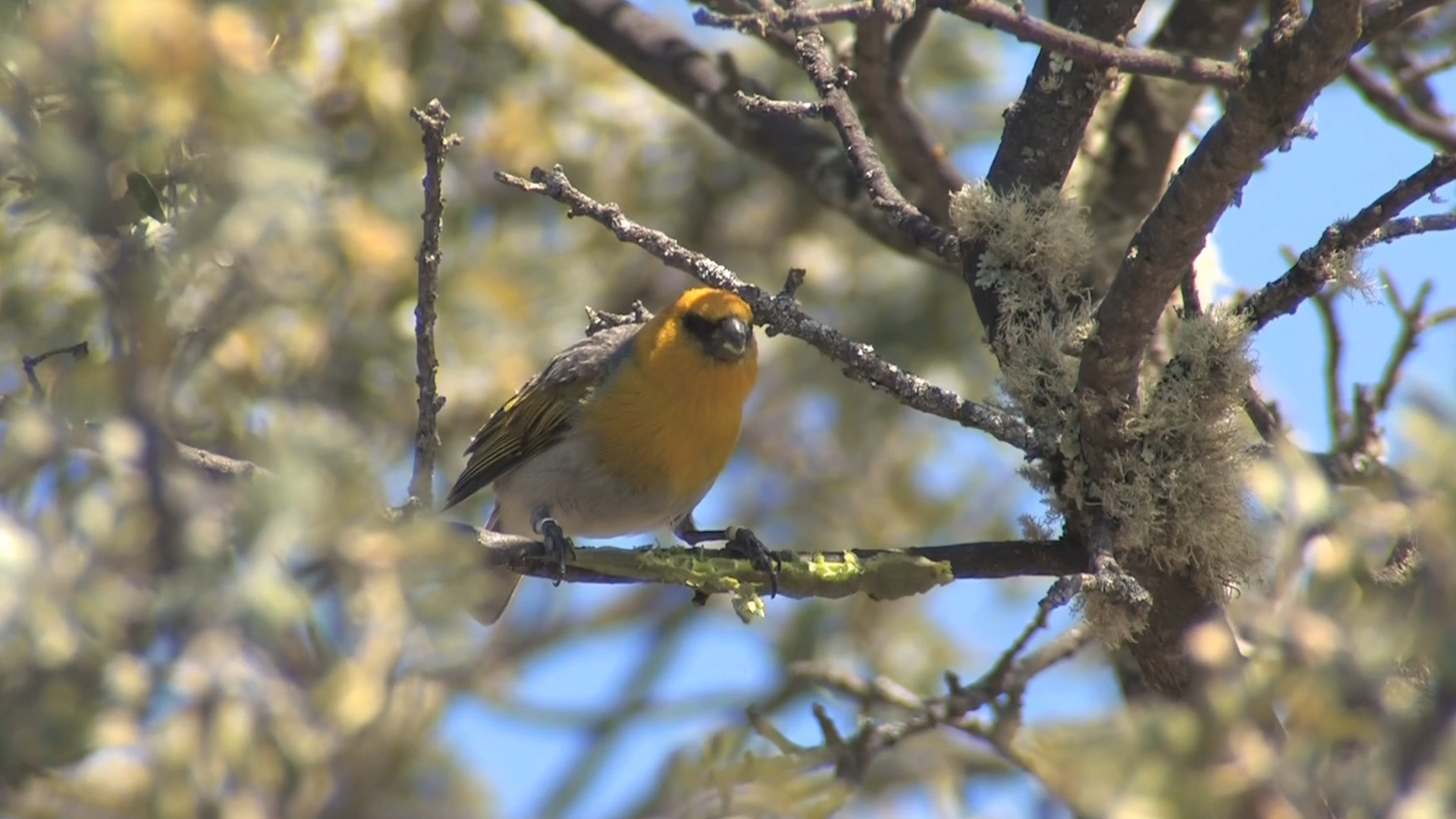(BIVN) – Two senate committees voted recommend the passage of a House resolution on Wednesday dealing with the future of the endangered palila bird, a native species that makes its home only on Maunakea.
House Concurrent Resolution No. 50 requests the Department of Land and Natural Resources “to provide updated statistics and facts relating to the decline of palila on Mauna Kea and investigate the factors causing the decline of the palila population.” As the resolution details, despite the eradication of sheep and goats on the higher elevations of Maunakea, the palila population continues to decline.
The Senate Committees on Water & Land and Agriculture & Environment both advanced the measure with a positive recommendation after a hearing.
From the HCR No. 50:
WHEREAS, the palila bird is a rare and critically endangered species of honeycreeper that can only be found on certain slopes of Mauna Kea in the County of Hawaii; and
WHEREAS, the palila has a close ecological relationship with the native mamane tree and it relies on those trees for food and nesting; and
WHEREAS, in 1979, a lawsuit was filed against the Department of Land and Natural Resources, alleging that the Department was “taking” palila for purposes of the federal Endangered Species Act by maintaining sheep and goats in the palila’s critical habitat, which included all of Mauna Kea from an elevation of six thousand feet to ten thousand feet; and
WHEREAS, between 1979 and 1999, the United States District Court confirmed a mandate that the Department of Land and Natural Resources eradicate sheep and goats from the palila’s critical habitat; and
WHEREAS, during that time, millions of dollars were spent on construction of fences and the eradication of sheep to comply with the order of the United States District Court; and
WHEREAS, more than twenty-five thousand sheep have been eradicated, with fewer than three hundred remaining as of 2022; and
WHEREAS, while efforts are made to salvage sheep meat, only about forty percent is typically recovered, leaving about sixty percent to rot or feed feral cats and mongoose, which are themselves a threat to the palila population; and
WHEREAS, despite the eradication of sheep and restoration of mamane forests, only an estimated three hundred palila were counted in 2021; and
WHEREAS, the routine cost of sheep eradication is expensive: in October 2022, $8,844.50 was spent to eradicate fifty-nine sheep; and
WHEREAS, due to the court mandate, thousands of residents have lost access to an important source of subsistence hunting on Mauna Kea; and
WHEREAS, the drastic reduction in sheep, combined with the recovery of vegetation on Mauna Kea, has resulted in an increase of vegetative fuel loads; and
WHEREAS, wildfires on the slopes of Mauna Kea represent the most significant threat to palila and their habitat; and
WHEREAS, recent fires have resulted in the destruction of approximately two hundred fifty acres of palila critical habitat; and
WHEREAS, due to the threat of fire, the Board of Land and Natural Resources has proposed a fuel break expansion project on Mauna Kea, which will remove thirty-five acres of mature mamane, which is another example of costs resulting from the United States District Court’s mandate; and
WHEREAS, despite the best efforts over the last forty years, the population of palila continues to be critically endangered; and
WHEREAS, further investigations must be conducted to determine why current efforts have not resulted in recovery of the palila, and to identify new strategies to preserve this species; now, therefore,
BE IT RESOLVED by the House of Representatives of the Thirty-second Legislature of the State of Hawaii, Regular Session of 2023, the Senate concurring, that the Department of Land and Natural Resources provide updated statistics and facts relating to the decline of palila on Mauna Kea; and
BE IT FURTHER RESOLVED that the Department of Land and Natural Resources investigate factors resulting in the decline of palila for purposes of recommending updated strategies to preserve this species and updating the United States District Court’s sheep and goat eradication mandate; and
BE IT FURTHER RESOLVED that the Department of Land and Natural Resources is requested to submit a report of its findings and recommendations, including any proposed legislation, to the Legislature no later than twenty days prior to the convening of the Regular Session of 2024; and
BE IT FURTHER RESOLVED that a certified copy of this Concurrent Resolution be transmitted to the Chairperson of the Board of Land and Natural Resources.
From the testimony provided by the Hawaiʻi Department of Land and Natural Resources in support of the measure:
The following is a summary of current and planned efforts by the Department to monitor and manage palila. Annual palila population surveys are conducted by the Department and the Pacific Cooperative Studies Unit (PCSU), University of Hawaiʻi, and other partners. A recent report published by the Department, PCSU, and United States (U.S.) Geological Survey showed that palila continue to decline on Mauna Kea, with population estimates of 1,432, 1,312, and 678 in 2019, 2020, and 2021, respectively (Genz et al. 2022). The 2021 population estimate of 678 palila is the lowest estimate since annual surveys began in 1998. The Department began conducting quarterly palila population surveys in 2022 to more closely monitor the palila population, and funding is being sought to analyze the resulting data collected in 2022 and 2023.
The Department has applied for funding from the U.S. Department of Defense to conduct a demographic study on palila to better understand causes of population decline and plan recovery actions for palila. If funded, this project will commence in Fiscal Year (FY) 24 and include monitoring of palila nests to determine whether invasive predators such as cats are implicated in the decline. Further funding to research sources of palila population decline is being sought from the U.S. Fish and Wildlife Service.
Three to four aerial shooting operations are conducted annually by the Department to remove the remaining sheep within Palila Critical Habitat. Approximately 25 “Judas” sheep with radio transmitters are used to locate and target the remaining sheep herds. In 2022, 267 sheep were removed via four aerial shoots. There are around 4,000 acres of Department of Hawaiian Home Lands within the Palila Critical Habitat fence that the Department is unable to access to complete animal control.
There remains approximately 7.7 miles of Palila Critical Habitat fence to be replaced. Capital Improvement Funds (CIP) awarded in 2020 and 2021 at $500,000 per year for two years are currently being used to complete the remaining five miles of fence replacement along the Parker Ranch border. That fencing work is under contract. A CIP request for $200,000 awarded in the FY 23 supplemental budget will be used to purchase materials to complete the 2.7 mile fence replacement on the Kukaiau Ranch border. The existing new and old fence continues to be maintained to address ongoing vandalism, damage from washouts, and gates being left open allowing sheep and goat ingress.
The Mauna Kea Forest Restoration Project continues to carry out reforestation in key areas within Palila Critical Habitat, as well as predator control and invasive plant management to benefit palila. Since 2007, the project has planted approximately 230,000 trees to restore and improve habitat conditions for palila. Plots are surveyed to monitor the forest recovery.
The Palila Hui is currently finalizing an action plan that outlines recovery actions for palila for the period 2023 to 2027.
Mitigating the risk of wildfire is another critical management action for palila. Fuel breaks and fire breaks continue to be maintained. The Department is in the process of expanding these fuel breaks to minimize the risk of a major fire in the region. We are seeking funding from U.S. Department of Defense to increase this effort and to maintain water sources for firefighting.
Mahalo for the opportunity to provide testimony in support of this measure.



by Big Island Video News5:11 pm
on at
STORY SUMMARY
HONOLULU - A House resolution requests the DLNR investigate the factors causing the decline of the palila population on Maunakea.